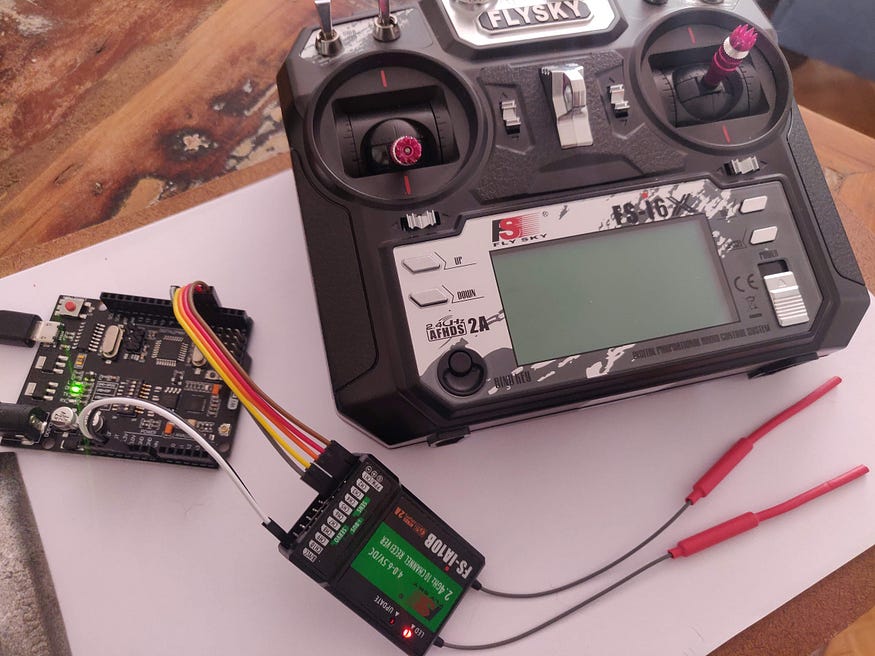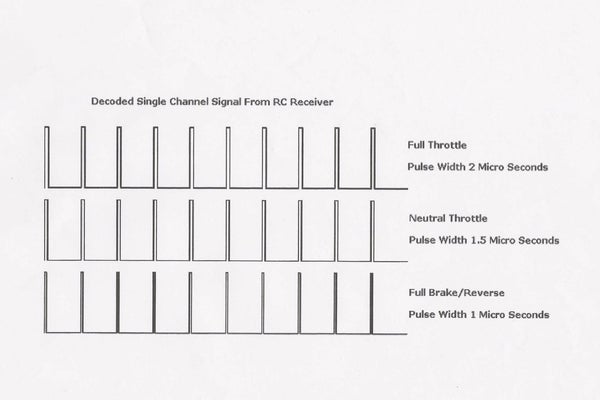이 글은 아두이노 기반 FS-IA10B RF 수신기 채널 신호 PWM(Pulse Width Modulation) 출력 방법을 간단히 정리한 것이다.
수신기에서 들어오는 PWM신호를 오실로스코프로 확인하면 다음과 같다.
이 PWM 진폭변조 신호는 진폭에 따라 수신기와 연결된 서보모터나 ESC(Electronic Speed Controller)와 연결된 모터를 제어하는 진폭 데이터를 포함하고 있다. 수신기의 각 채널은 진폭 데이터를 송신기에서 전달받아 모터에 전달함으로서 모터의 속도나 회전각도를 제어할 수 있다.문제는 각종 센서나 ROS(ROBOT OPERATING SYSTEM)에서 처리한 정보에 근거해 PWM을 강제로 수정, 로봇 등을 제어해야할 때이다. 이 경우, 수신기와 아두이노 같은 임베디드 보드 GPIO를 연결해 PWM데이터를 얻어, 이를 수정한 후 PWM데이터로 출력해야 한다.
수신기 제작 업체에서 제공하는 IBUS 등 라이브러리가 있으나, 여기서는 가장 코딩하기 쉬운 방법을 이용해 처리한다.
다음과 같이 코딩하고, 각 채널을 수신과 아두이노의 해당 핀에 연결하여 테스트해본다.
// title: MSR_RF2
// developed by: KTW
// date: 2020.11.5
#include <Servo.h>
#define CH1 2
#define CH2 3
#define CH3 4
#define CH4 5
#define CH5 6
Servo ESC1; // create servo object to control the ESC
Servo ESC2;
Servo ESC3;
Servo ESC4;
// Read the number of a given channel and convert to the range provided.
// If the channel is off, return the default value
int readChannel(int channelInput, int minLimit, int maxLimit, int defaultValue){
int ch = pulseIn(channelInput, HIGH, 30000);
if (ch < 100) return defaultValue;
return map(ch, 1000, 2000, minLimit, maxLimit);
}
// Red the channel and return a boolean value
bool redSwitch(byte channelInput, bool defaultValue){
int intDefaultValue = (defaultValue)? 100: 0;
int ch = readChannel(channelInput, 0, 100, intDefaultValue);
return (ch > 50);
}
void setup(){
Serial.begin(115200);
pinMode(CH1, INPUT);
pinMode(CH2, INPUT);
pinMode(CH3, INPUT);
pinMode(CH4, INPUT);
pinMode(CH5, INPUT);
ESC1.attach(8,1000,2000); // (pin, min pulse width, max pulse width in microseconds)
ESC2.attach(9,1000,2000);
ESC3.attach(10,1000,2000);
ESC4.attach(11,1000,2000);
}
int ch1Value, ch2Value, ch3Value, ch4Value;
bool ch5Value;
void loop() {
ch1Value = readChannel(CH1, 0, 180, 0);
ch2Value = readChannel(CH2, 0, 180, 0);
ch3Value = readChannel(CH3, 0, 180, 0);
ch4Value = readChannel(CH4, 0, 180, 0);
ch5Value = redSwitch(CH5, false);
Serial.print("Ch1: ");
Serial.print(ch1Value);
Serial.print(" Ch2: ");
Serial.print(ch2Value);
Serial.print(" Ch3: ");
Serial.print(ch3Value);
Serial.print(" Ch4: ");
Serial.print(ch4Value);
Serial.print(" Ch5: ");
Serial.println(ch5Value);
ESC1.write(ch1Value);
ESC2.write(ch2Value);
ESC3.write(ch3Value);
ESC4.write(ch4Value);
delay(500);
}
이제, 오실로스코프 두개 프로브에 각각 수신기 채널, 아두이노 출력 핀을 연결한다. 아두이노 수직 채널 입력 전압을 2V로 조정하고, 수평은 1.0 ms로 설정한다. 그리고, TRIGGER AUTO 버튼으로 시그널 수평을 고정한다. 그럼, 다음과 같이 입력후 처리된 PWM 진폭이 각각 일치하는 것을 확인할 수 있다.
PWM 처리 결과
이런 방식으로 각종 센서나 데이터에 근거해 RF PWM 신호를 변조하여 액추에이터 등을 제어할 수 있다.
레퍼런스
- How to read RC signal with Arduino using FlySky iBus
- Arduino Flysky/Turnigy RC iBus protocol handler
- How to read RC receiver signal with Arduino
- FlySkyIBus
- analogWrite
- Arduino Brushless Motor Control Tutorial | ESC | BLDC
- Decoding RC Signals using Arduino
- Arduino Brushless Motor Control Tutorial | ESC | BLDC
- Electronic Speed Controller (ESC) Calibration
- Arduino Drone V2.0
- Documentation for the ESC, IMU and Arduino IDE Code
- HC480A type 3. 1PC 10V-32V 12V 24V 480A/960A Brush ESC bidirectional 3S-6S Speed Control for RC Rock Crawler Boats Tank No Brake



댓글 없음:
댓글 쓰기